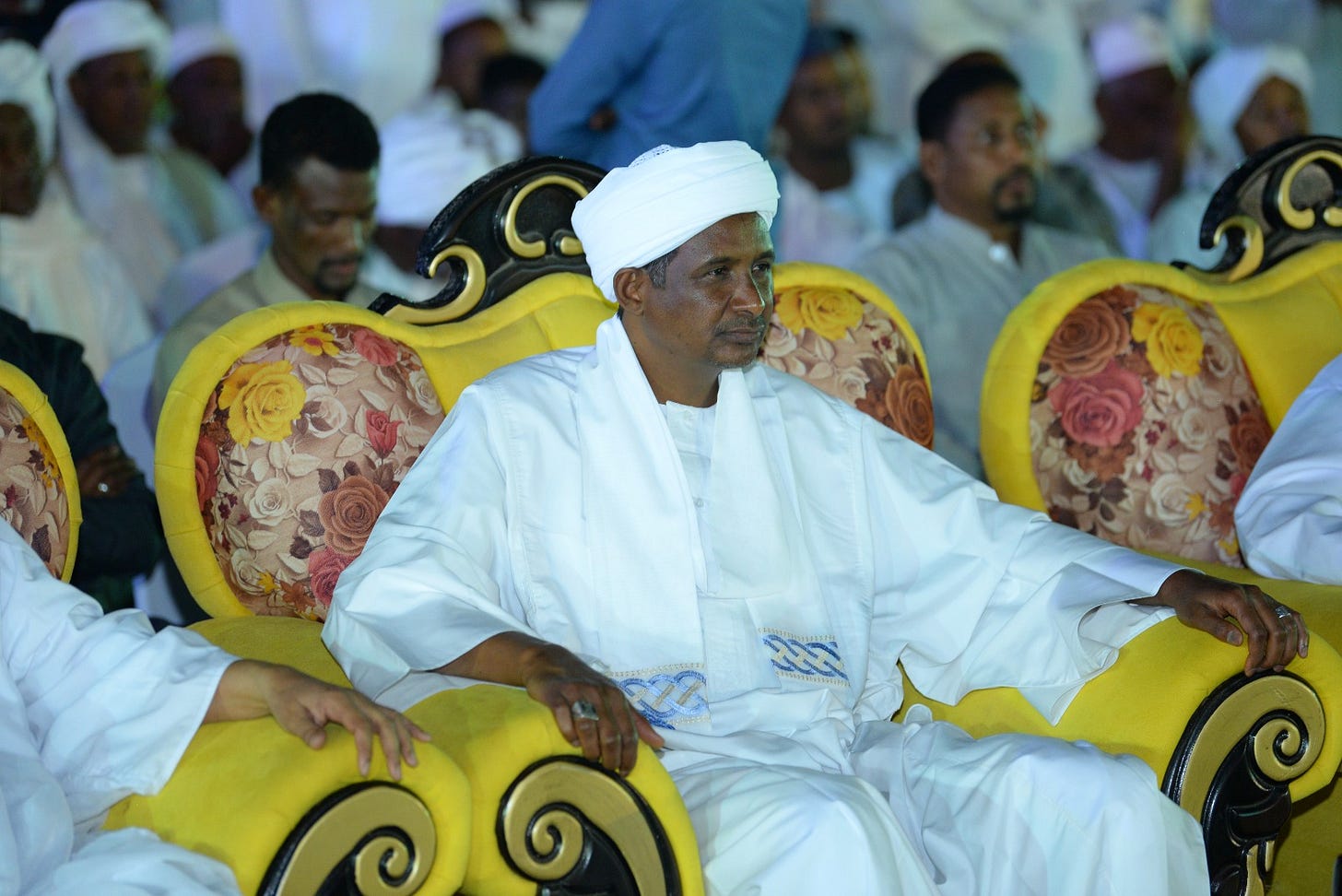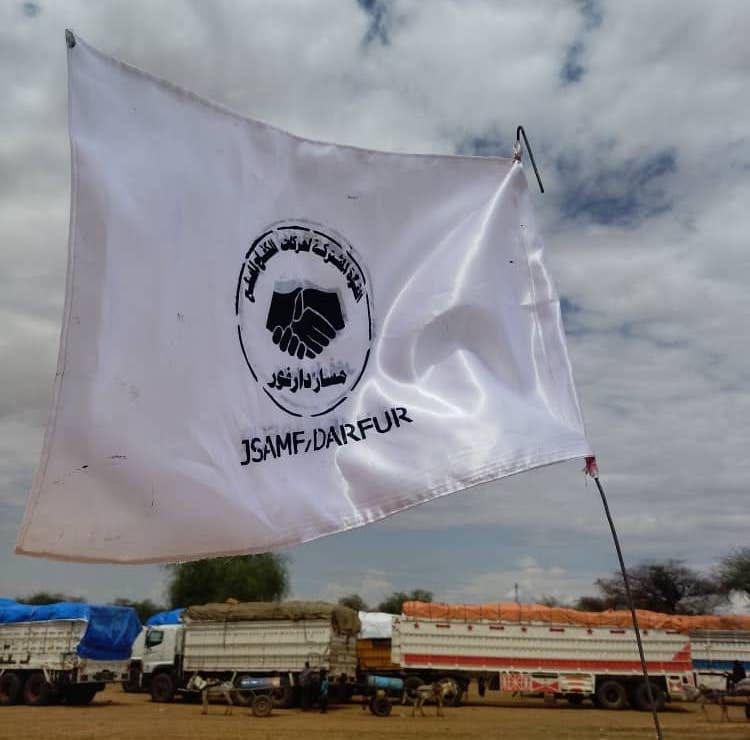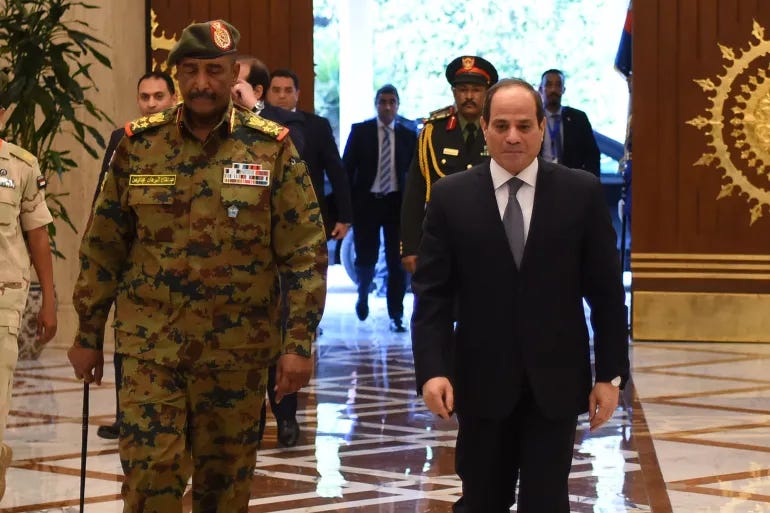Who’s Who in Sudan’s Civil War?
A glossary of key individuals, groups, and abbreviations for understanding the conflict

EDITOR’S NOTE: This post was published in 2023 and may contain information that is now out-of-date.
Quick guide to abbreviations
SAF: Sudan Armed Forces, led by Abdel Fattah al-Burhan
RSF: Rapid Support Forces, led by Mohammed Hamdan Dagalo (“Hemedti”)
SLM/A: Sudan Liberation Movement/Army, with several factions
JEM: Justice and Equality Movement, currently undergoing a schism
SPLM-North: Sudan People’s Liberation Movement (North), with several factions
JSAMF: Joint Struggle Armed Movement Forces (Juba Peace Signatories)
FFC: Forces of Freedom and Change
Principal belligerents
Sudan Armed Forces (SAF): The regular forces of the Sudanese government. They staged a coup in 2021 overthrowing the joint civilian-military government that had ruled since soon after the 2019 fall of dictator Omar al-Bashir. SAF are one of two main protagonists in the war. The Sudanese military previously fought several other long wars, including against the Sudan People’s Liberation Movement in South Sudan (1983-2005), against the SPLM-North in the Nuba Mountains (2011-present), and against a number of different Darfur rebel groups (2003-2020). However, this is the first war they have fought that involves protracted urban conflict in the nation’s Nile Valley heartland, including the capital Khartoum.
Rapid Support Forces (RSF): A paramilitary organization formed from ethnic militias, supported by the Sudanese government in the early and mid-2000s, known popularly as the Janjaweed. The RSF are one of two main protagonists in the current war. They are fighting for control of the government and the capital. Most of the leaders and soldiers of the RSF belong to Arab tribes from the west of Sudan, giving the conflict an ethnic dimension. Their stated politics are democratic and anti-Islamist, but in fact they massacred protesters in June 2019 and supported the anti-democratic coup of October 2021. They have committed widespread atrocities and mass arrests in Khartoum and Darfur since the outbreak of the conflict in April 2023.
Key individuals
Mohamad Hamdan Dagalo – The leader of the Rapid Support Forces (RSF), known by his nickname “Hemedti.” He led janjaweed militias during the Darfur counter-insurgency, before becoming leader of the RSF after Sudan’s government formalized it as an institution in 2013. After helping the Sudanese military to detain and overthrow President al-Bashir in 2019, Hemedti became deputy chairman of the Transitional Military Council, then deputy chairman of the Transitional Sovereignty Council.
Revered by his soldiers as a champion warrior, statesman, and “son of the desert” (i.e., nomadic Arab of Darfur), Hemedti claims to seek the restoration of democracy in Sudan and the ouster of former regime leaders. However, his own troops hail him as “commander-in-chief” and sometimes “emir” or “president,” hinting at Hemedti’s personal ambitions. At the start of the current war in April 2023, Hemedti’s troops sought to kill or capture al-Burhan, chairman of the Sovereignty Council, battling the presidential guards and killing dozens of them.
Abdel Fattah al-Burhan – Commander-in-chief of Sudan’s armed forces and chairman of the Transitional Sovereignty Council. A career soldier, al-Burhan led a military council that took power after the popular revolution that led to the ouster of long-time dictator Omar al-Bashir in April 2019. Al-Burhan then partly ceded control to civilian-nominated representatives in August 2019, including Prime Minister Abdalla Hamdok. After two years, however, the military ousted Hamdok and other civilian leaders in October 2021, restoring military rule. From 2022 through early 2023 al-Burhan shared power with the RSF leader Mohamed Hamdan Dagalo, who grew increasingly prominent, powerful, and openly ambitious during this period.
Al-Burhan spent the first four months of the war at the frontline in Khartoum, where he was ultimately surrounded and besieged at the Armed Forces headquarters. He managed to leave Khartoum in mid-August as a result of a secret operation. Then he visited troops in Omdurman, Atbara, and Port Sudan, vowing that the army would crush the rebellion and downplaying the possibility of a negotiated solution. Al-Burhan is characterized by critics as an Islamist close to top officials of the former regime, but he has downplayed his ties to any particular political party or ideology.
Omar al-Bashir - Though not a public figure in the current conflict, the former dictator casts a long shadow. His past decisions helped created the conditions for the current war; as the former patron of the Rapid Support Forces, al-Bashir helped it rise to power at the expense of the military, which he distrusted. Al-Bashir is rumored to be living at a military hospital in Omdurman, which is controlled by SAF but surrounded by RSF. Wanted by the International Criminal Court, al-Bashir is also at risk of capture by the RSF. Despite their former allegiance to al-Bashir, the RSF now frequently blame him and other former regime leaders for the country’s current woes.
Shams ad-Din Kabbashi - Deputy commander-in-chief of Sudan’s military, Lieutenant General Kabbashi is a key part of the military government, serving as a member of the Sovereignty Council both before and after the October 2021 coup. He was the public face of the military after the ouster of al-Bashir in 2019, representing them in negotiations with political parties, resistance committees, and other civilian actors, which led to the creation of a civilian government headed by Abdalla Hamdok. Ethnically Nuba, Kabbashi is a favorite target of RSF vitriol. Kabbashi appeared in videos at General Command during the first months of the war. If he remains at that location, he is at risk of capture if the base falls.
Yasser al-Atta - Assistant commander-in-chief of the Sudan Armed Forces (SAF) and a member of the Sovereignty Council, Lieutenant General Yasser al-Atta has made video appearances in recent months from the Corps of Engineers and Medical Corps complex in Omdurman where al-Bashir is also said to be living.
Malik Agar - Deputy leader of the Sovereignty Council, chosen by al-Burhan in May to replace Hemedti after chances for a negotiated solution with the RSF had dimmed. Agar is a longtime leader of the secularist Sudan People’s Liberation Movement (SPLM), which fought the Sudanese government in South Sudan, Blue Nile, and the Nuba Mountains. As a native of Blue Nile State, Malik Agar led SPLM rebels there before the Comprehensive Peace Agreement of 2005. Briefly, he served as governor of Blue Nile after winning an election in 2010, but was deposed by al-Bashir soon thereafter. He led a breakaway faction of the SPLM (SPLM-North) after the war resumed in Blue Nile in 2011, coinciding with South Sudan’s independence. Unlike the SPLN-North leader in the Nuba Mountains, Abdelaziz al-Hilu, Agar signed the Juba Peace Agreement with the government in 2020.
Agar was appointed a member of the Sovereignty Council in November 2021, shortly after the military coup, angering protest leaders that were opposing the military government at that point. His forces are in the process of being fully integrated within the Sudan Armed Forces and are fighting alongside the army against the RSF.

Agar became the principal face of the Sudanese government while al-Burhan was trapped at General Command (July-August), chairing cabinet meetings, meeting United Nations and humanitarian officials, and making foreign visits.
Abdel Rahim Dagalo - Brother of “Hemedti” and deputy commander of the Rapid Support Forces, he has nearly the same cult status as Hemedti within the ranks of the RSF. Along with Hemedti, Abdel Rahim controls Al Junaid Multi Activities Co Ltd, a sprawling business empire involved in gold mining and other industries. Abdel Rahim is the likely successor of Hemedti in the event that the latter is killed. He spent the first months of the war in Khartoum, before traveling to Chad and the United Arab Emirates for talks with foreign contacts and other Darfur armed groups.
Minni Minawi - Governor of Greater Darfur, Minawi was involved in talks with Hemedti and al-Burhan in the hours before the war broke out, trying to broker a solution to their differences. As the long-time leader of one of the most important factions of the Sudan Liberation Movement/Army, Minawi has thousands of fighters at his command, but they have not actively participated in the conflict on other side. If they were to join the war, the situation in North Darfur likely would deteriorate rapidly. The SLA has a decades-long history of conflict with both SAF and RSF, but so far has remained neutral as its two former foes battle each other. Minawi has served as regional governor since April 2021, when then-Prime Minister Abdallah Hamdok appointed him in accordance with the terms of the Juba Peace Agreement.
Other armed groups
SPLM-North (Al-Hilu) – Breakaway faction of the Sudan People’s Liberation Movement, the ruling party of South Sudan, which made peace with the Sudanese government in 2005 before securing independence of South Sudan in a referendum in 2011. After this, some territories controlled by SPLM remained north of the border, including in the Nuba Mountains of South Kordofan. Fighters in this area continued the insurgency, led by Abdelaziz al-Hilu. They control large parts of South Kordofan, but not the major towns. Al-Hilu declined to sign the Juba Peace Agreement of 2020, unlike the leader of the SPLM-North faction in Blue Nile State, Malik Agar. Since the outbreak of the war between SAF and RSF, al-Hilu’s troops have gained ground in several areas of South Kordofan, taking advantage of the army’s weakness. SPLM-N is not formally aligned with either RSF or SAF.
JSAMF - The Joint Struggle Armed Movement Forces is a joint force of former Darfur rebel groups, principal among which is the Sudan Liberation Army led by Minni Minawi. Formed after the Juba Agreement, the Joint Force also includes JEM and the Gathering of the Sudan Liberation Forces (GLSF). Its principal power base is in Al Fasher and some rural areas of North Darfur. Under the terms of the Juba Agreement, the Joint Force was meant to be 12,000 strong, including 6,000 former rebels and 6,000 government troops, but the government never assigned troops to take part in it. Since the start of the current war between SAF and RSF, JSAMF have sought to remain neutral, leveraging their neutral position to escort commercial convoys from Port Sudan to the western regions of Kordofan and Darfur.
Justice and Equality Movement (JEM) – A former rebel group, which fought Sudan’s government in Darfur and Kordofan from 2002 until 2020, and once also launched an attack on the capital in 2008. The current conflict has divided the movement, resulting in a split into two factions, one led by Jibril Ibrahim and the other by Suleiman Sandal Haggar, JEM’s political secretary. Ibrahim, brother of the late founder of JEM, has served as Sudan’s finance minister since February 2021, in accordance with the power-sharing provisions of the 2020 Juba Peace Agreement. Politically, he is therefore closely aligned with the government of al-Burhan; however, the armed elements of the movement have not integrated with the Sudan Armed Forces, nor have they fought against either SAF or RSF since the civil war erupted in April, apart from some isolated incidents. Instead, many JEM troops are serving in the Joint Force led by Minni Minawi.
Sudan Liberation Movement (Minawi) — Refer to “Minni Minawi” and “JSAMF.”
Sudan Liberation Army - Abdel Wahid Al Nur (SLA-AW) – Based in a mountainous region of Central Darfur known as Jebel Marra, the SLA-AW refused to sign the Juba Peace Agreement of 2020. They control few population centers in Darfur and have not been politically significant in national politics. But SLA-AW is one of the oldest and best known Darfur rebel groups. They adamantly opposed the 2020 Juba Agreement with the Sudanese government, unlike the SLM-Minawi and JEM, which signed the Juba agreement and thereby won appointments to government positions.

Local ethnic militias: Many civilians in rural areas of Sudan are armed, and these gunmen often organize themselves along ethnic lines. Tribal leaders, also called Native Administration leaders, therefore can be important players in instigating or resolving conflict, and they sometimes align themselves with one party or the other. Examples of this include the Arab tribal leaders of Darfur, some of whom (but not all) declared their loyalty to the Rapid Support Forces, and the nazir (senior chief) of the Beja in eastern Sudan, Sayed Tirik (pictured bottom row center in the lead photo of this article), who aligned with SAF. Some local leaders tried to navigate a middle path, not aligning openly with one side or the other, such as the Misseriya Arab leaders of West Kordofan.
International initiatives
IGAD Quartet: A group of four East African nations—Kenya, Ethiopia, Djibouti, and South Sudan—which has called on both sides to stop fighting, holding a presidential summit in July at which they issued a communique. However, the Sudan Armed Forces boycotted the IGAD summit, accusing the group’s chairperson, Kenyan President William Ruto, have having business ties with the Rapid Support Forces. IGAD is an abbreviation for “Intergovernmental Authority on Development,” the name for an eight-country East African bloc of countries founded in 1986.
Jeddah Platform: The foreign ministries of Saudi Arabia and the United States hosted talks in Jeddah, Saudi Arabia, in May and June 2023, seeking to broker an end to the fighting. This resulted in a series of short-term ceasefires, most of which were broken—sometimes in spectacular fashion. Informal talks and contacts among the parties and mediators have continued since then, but without any discernible progress.
Cairo Summit: A meeting of regional leaders held in July, hosted by Abdel Fattah El-Sisi. This gathering was the most pro-SAF of all the recent international initiatives, reflecting the close ties between the Egyptian and Sudanese militaries. Although Egypt hasn’t openly announced military support to Sudan’s Armed Forces, they dispatched at least one naval auxiliary supply ship to Port Sudan, and they provided technical assistance to Sudan’s Air Force, according to some media reports. Egyptian support, however, is hamstrung by a currency crisis and fiscal problems in Egypt. In addition to hosting this summit, El-Sisi rolled out the red carpet for al-Burhan during a visit in August, during which he affirmed strong support for Sudan’s security, stability, and territorial integrity, highlighting “eternal” ties between the two nations.
United Nations Integrated Transition Assistance Mission in Sudan (UNITAMS): A special political mission established by the United Nations in 2020, coinciding with the withdrawal of the long-time Darfur peacekeeping mission known as UNAMID. The mission’s mandate was to assist with a political transition toward civilian role and provide support to peace processes. The mission is headed by Volker Perthes, whom the Foreign Ministry declared persona non grata in June.
Anti-war groups
Forces of Freedom and Change (FFC) — A political coalition formed during the Sudanese Revolution, which negotiated a transitional agreement with the Transitional Military Council in July 2019 to return Sudan to democratic rule. FFC chose five civilian members to serve on the Transitional Sovereignty Council created jointly with the military, until their removal after the military coup of October 2021.
FFC rejected that coup and has criticized both sides in the current civil war. Key constituents of the coalition are the Sudanese Professionals Association, National Consensus Forces, Unionist Gathering, and the Umma Party. The coalition is led by Khaled Omar Youssef, a former minister of cabinet affairs.
Resistance Committees — Formed as leadership cells of the protesters during the “Glorious Revolution” of 2018-2019, these committees are generally opposed to the war, though many refer to the RSF as a “rebel militia” and some have openly sided with the Sudan Armed Forces. Nevertheless, both SAF and RSF have targeted leaders and volunteers working with the resistance committees, beating and arresting them, and using the conflict as an excuse to settle political scores.
The Resistance Committees are a decentralized network of activists rather than a single organization, drawing on large grassroots support networks in the neighborhoods of the capital and other cities. This has enabled them to step into humanitarian roles, running food banks, ‘emergency rooms’ that provide volunteer labor to hospitals, coordinating evacuation routes, and digging graves for war victims. Politically, many Resistance Committees leaders are left-leaning and secular in orientation, but the committees don’t represent a single party or idea but rather a diverse subset of Sudanese society opposed to authoritarianism, militarism, and corruption. The Resistance Committees not only led the revolution against al-Bashir in 2019 but led protests across Sudan from October 2021 through early 2023 after the coup that topped the civilian government of Abdalla Hamdok.






